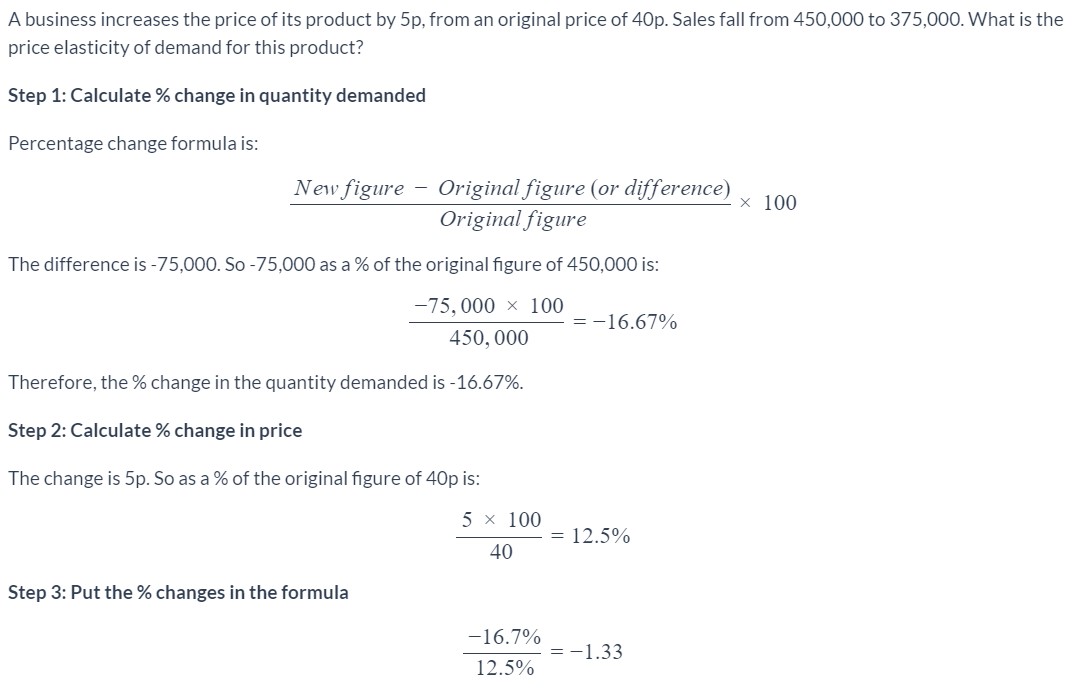Price Elasticity of Demand
1/16
There's no tags or description
Looks like no tags are added yet.
Name | Mastery | Learn | Test | Matching | Spaced |
|---|
No study sessions yet.
17 Terms
What is price elasticity of demand?
Price elasticity of demand measures the responsiveness of demand to a change in price.
How is price elasticity of demand calculated?
Price elasticity of demand is calculated by using the following formula:
PED= % change in quantity demanded / % change in price
Worked example: Calculating PED.

What are the 3 catergories that PED values are placed into?
Price elastic
Price inelastic
Unitary elastic
A PED value of more than 1 suggest that a product is…
Price elastic.
What does price elastic mean?
A change in price will cause a more than proportional change in the quantity demanded.
The level of demand is sensitive to a change in price.
If price increases, demand falls dramatically.
If price decreases, demand increases dramatically.
A PED value of less than 1 suggest that a product is…
Price inelastic.
What does price inelastic mean?
This means that a change in price will cause a less than proportional change in the quantity demanded.
The level of demand is not sensitive to a change in price.
If price increases, demand falls just a little.
If price decreases, demand increases just a little.
A PED value of 1 suggests that a product is…
Unitary elastic- This means that a change in price will cause an equal and proportional change in the quantity demanded.
What types of products are likely to be price elastic?
Price elastic products are more likely to be luxury products (such as sports cars, exotic holidays, organic bread); if they become more expensive, less people will demand them and vice versa.
When is inelastic price elasticity of demand likely to occur?
When the levels of competition are low, when there are few substitutes or the goods are necessities or perhaps addictive.
What types of products are likely to be price inelastic?
Price inelastic products are more likely to be necessity products (such as water, power, petrol, basic foods, and addictive goods, such as cigarettes); if they become more expensive, most people will still demand them and vice versa.
What factors affect price elasticity of demand?
Brand strength- products with strong brand loyalty and reputation tend to be price inelastic.
Necessity- Necessities tend to be more product inelastic.
Availability of substitutes- Products which have many alternatives available tend to be more price elastic.
How is revenue affected if demand is price elastic?
If prices are lowered, the revenue from each item sold falls, but the quantity sold increases more than proportionately which means that total revenue increases.
From a business point of view, if demand for the good is elastic then revenues will increase if your price falls, so it can make sense to cut prices.
Likewise, if prices are increased then demand will fall more than proportionately to the change in price, leading to a fall in revenue
How is revenue affected if demand is price inelastic?
If demand is price inelastic, a rise in price will lead to a rise in sales revenue. Likewise, a fall in price will lead to a fall in sales revenue.
This means that although sales have increased, the fall in revenue from each item sold results in total revenue falling. From a business point of view, if demand for the good is inelastic, revenues will fall if your price falls, so it rarely makes sense to cut prices.
How is profit affected if demand is price elastic?
If demand is price elastic, an increase in sales revenue can be achieved by lowering price and raising sales. But higher sales also mean higher costs. In this situation, higher profits will only occur if the increase in sales revenue is greater than the increase in costs.
How is profit affected if demand is price inelastic?
If demand is price inelastic, a rise in price will lead to lower sales but increased sales revenue, however the lower sales will mean lower variable costs. So, profits will increase, not just from higher sales revenue but also from lower costs.